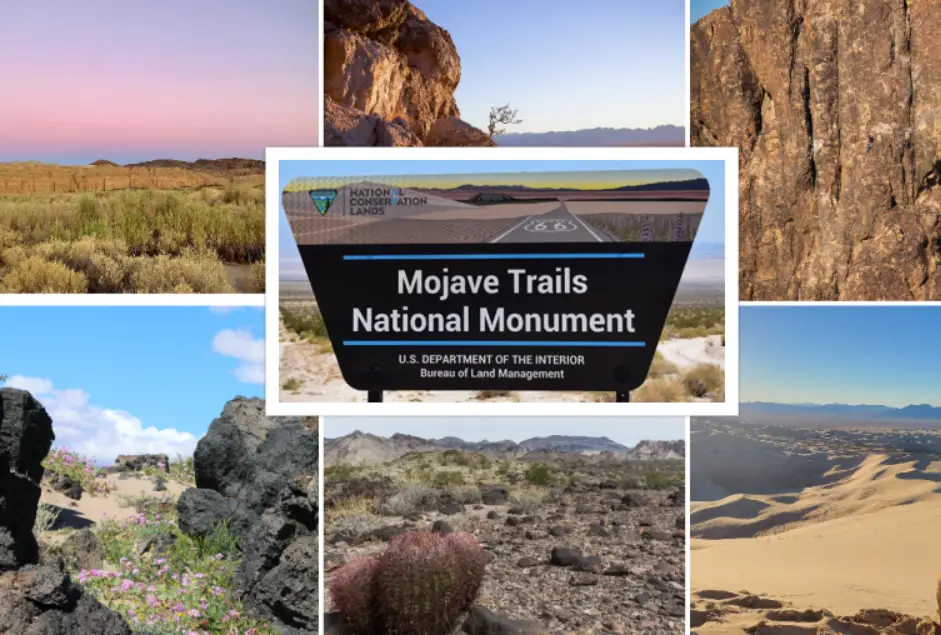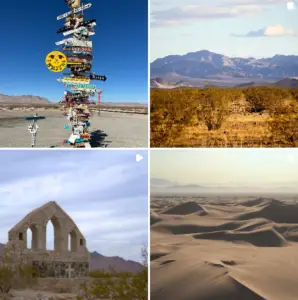Mojave Trails National Monument : Interesting Facts, History & Travel Guide

- By
- Aparna Patel
- |
- 12 Apr, 2023
- |

Mojave Trails National Monument is a vast and rugged landscape located in southeastern California, offering visitors a unique and unforgettable outdoor experience. From its ancient rock art to its diverse wildlife, there is much to explore and discover within the monument’s 1.6 million acres.
In this blog, we’ll delve into the fascinating history and culture of the area, as well as offer a comprehensive travel guide for those looking to visit. Whether you’re a seasoned outdoors enthusiast or simply looking for a new adventure, Mojave Trails National Monument is sure to impress.
Interesting facts about Mojave Trails National Monument
- Mojave Trails National Monument is located in southeastern California and covers over 1.6 million acres of pristine desert landscape.
- The monument was established by President Barack Obama in February 2016 and is managed by the Bureau of Land Management.
- Mojave Trails National Monument is home to a diverse range of wildlife, including bighorn sheep, desert tortoises, and several species of birds and reptiles.
- The monument contains important cultural and historical sites, including ancient rock art, Native American trails, and the remnants of a 1920s-era automobile route known as the “Old Spanish Trail.”
- The monument also includes the historic Route 66, a famous highway that stretched from Chicago to Los Angeles and served as a major transportation route for travelers and migrants during the 20th century.
- Mojave Trails National Monument is also known for its unique geological formations, including the towering granite spires of the Mojave National Preserve and the rugged lava flows of the Cadiz Dunes Wilderness Area.
- Visitors to the monument can enjoy a wide range of recreational activities, including hiking, camping, rock climbing, and wildlife watching.
- Mojave Trails National Monument is an important area for conservation and is home to several threatened or endangered species, including the desert tortoise and the Mojave fringe-toed lizard.
- The monument is also a popular destination for stargazing, due to its remote location and lack of light pollution.
- Mojave Trails National Monument is an important part of California’s natural and cultural heritage, and serves as a reminder of the region’s rich history and unique beauty.
Read More:
- Mojave Trails National Monument : Interesting Facts, History & Travel Guide
- Misty Fjords National Monument : Interesting Facts, History & Travel Guide
- Mill Springs Battlefield National Monument : Interesting Facts, History & Travel Guide
- Medgar and Myrlie Evers Home : Interesting Facts, History & Travel Guide
- Marianas Trench Marine National Monument : Interesting Facts, History & Travel Guide
- Little Bighorn Battlefield National Monument : Interesting Facts, History & Travel Guide
- Lava Beds National Monument : Interesting Facts, History & Travel Guide
Information & History of Mojave Trails National Monument
Mojave Trails National Monument is a protected area located in southeastern California, covering over 1.6 million acres of desert landscape. The monument was established by President Barack Obama in February 2016 and is managed by the Bureau of Land Management.
The monument is home to a diverse range of wildlife, including bighorn sheep, desert tortoises, and several species of birds and reptiles. It also contains important cultural and historical sites, including ancient rock art, Native American trails, and the remnants of a 1920s-era automobile route known as the “Old Spanish Trail.”
One of the most significant historical features of the monument is the historic Route 66, a famous highway that stretched from Chicago to Los Angeles and served as a major transportation route for travelers and migrants during the 20th century. Route 66 is now a popular tourist attraction, and many visitors come to the monument to experience its unique blend of natural and cultural history.
The monument is also known for its unique geological formations, including the towering granite spires of the Mojave National Preserve and the rugged lava flows of the Cadiz Dunes Wilderness Area. The area is home to several threatened or endangered species, including the desert tortoise and the Mojave fringe-toed lizard, and is an important part of California’s natural and cultural heritage.
Mojave Trails National Monument was established to preserve the unique natural and cultural resources of the region, and to provide opportunities for visitors to enjoy and learn about this important part of California’s history and landscape.
Travel Guide for Mojave Trails National Monument
Mojave Trails National Monument is a vast and rugged landscape that offers a variety of outdoor recreational opportunities. Here is a travel guide to help you plan your visit to this unique and beautiful area:
- Getting there: The monument is located in southeastern California, about two hours east of Los Angeles and two hours southwest of Las Vegas. The main entrance to the monument is located off of Interstate 40, and several other roads provide access to different areas of the monument.
- Camping: There are several campgrounds located within the monument, offering a range of camping experiences from rustic tent camping to full RV hookups. Reservations are recommended, especially during peak season.
- Hiking: There are several hiking trails located within the monument, ranging from short, easy walks to challenging backcountry hikes. Some popular trails include the Marble Mountains, Kelso Dunes, and Piute Range.
- Wildlife viewing: The monument is home to a diverse range of wildlife, including bighorn sheep, desert tortoises, and several species of birds and reptiles. Visitors are encouraged to view wildlife from a safe distance and to respect their habitat.
- Cultural and historical sites: The monument contains several important cultural and historical sites, including ancient rock art, Native American trails, and the remnants of the historic Route 66. Visitors are encouraged to learn about the history of the area and to respect these important sites.
- Stargazing: The monument’s remote location and lack of light pollution make it a popular destination for stargazing. Visitors are encouraged to bring binoculars or a telescope and to enjoy the stunning night sky.
- Safety: The desert environment can be challenging, so visitors are encouraged to come prepared with plenty of water, sunscreen, and appropriate clothing. Visitors should also be aware of potential hazards, such as flash floods, rattlesnakes, and extreme heat.
Mojave Trails National Monument offers a unique and unforgettable outdoor experience for visitors of all ages and interests. Whether you’re looking to hike, camp, or simply enjoy the stunning natural beauty of the area, Mojave Trails has something to offer everyone.
Mojave Trails National Monument camping
Mojave Trails National Monument offers several camping options for visitors looking to experience the rugged beauty of the desert landscape. Here are some of the camping options available within the monument:
- Hole-in-the-Wall Campground: This campground is located in the heart of the Mojave National Preserve and offers 35 campsites for tent and RV camping. The campground is open year-round and offers picnic tables, fire pits, and pit toilets.
- Black Canyon Equestrian and Group Campground: This campground is located on the eastern edge of the monument and offers 25 campsites for tent and RV camping. The campground is open year-round and offers picnic tables, fire pits, and flush toilets.
- Mid Hills Campground: This campground is located in the Mojave National Preserve and offers 26 campsites for tent camping only. The campground is open year-round and offers picnic tables, fire rings, and pit toilets.
- Kelso Dunes Campground: This campground is located in the Mojave National Preserve and offers 10 campsites for tent camping only. The campground is open year-round and offers picnic tables, fire rings, and pit toilets.
- Roadside Camping: There are several areas within the monument where visitors are allowed to camp along designated roadside areas. These areas offer a more primitive camping experience and do not have amenities such as picnic tables or toilets.
More Articles
It’s important to note that camping within the monument is primitive and visitors should come prepared with plenty of water, food, and appropriate gear for the desert environment. Visitors are also asked to practice Leave No Trace principles and to respect the natural environment by packing out all trash and following all posted regulations.
Search Posts
Latest posts
-
5 Mar, 2024
How to avoid drinking vodka?
Popular posts
-
5 Mar, 2024
Why prohibit engine braking?
